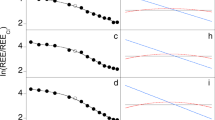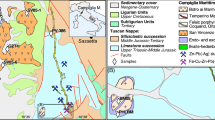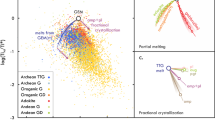Abstract
Subduction of rocks into the mantle results in high-pressure metamorphism and the formation of eclogites from basaltic precursor rocks. At the Earth’s surface, eclogites often occur as isolated fragments embedded in crustal rocks that lack evidence for high-pressure conditions1,2,3. The high-pressure rocks are therefore often viewed as dismembered fragments that have been assembled and intercalated with rocks devoid of any high-pressure history at shallow crustal levels4,5,6,7,8, forming a tectonic mélange. Such mélange models were supported by age discrepancies among high-pressure rocks from the Adula nappe (Central Alps)9,10,11,12, which was thought to represent a classic example of such a situation4,5. Here we present Lu–Hf age data from two populations of the high-pressure mineral garnet, found within a single eclogite sample taken from Trescolmen, in the Central Adula nappe. We report a minimum Variscan age of 332.7 Myr and a maximum Alpine age of 38 Myr for the two populations. We suggest that the Trescolmen eclogite was subducted to mantle depth and subsequently exhumed, becoming part of a continental crust during the Variscan orogeny. Later, during the Alpine orogeny, the Adula nappe must have been subducted to—and exhumed from—mantle depth a second time, as one coherent unit. We conclude that the Adula nappe is not a mélange, and therefore, the crustal rocks that envelope the eclogites have also been subjected to high-pressure conditions through deep subduction during the Alpine event13,14.
This is a preview of subscription content, access via your institution
Access options
Subscribe to this journal
Receive 12 print issues and online access
$259.00 per year
only $21.58 per issue
Buy this article
- Purchase on Springer Link
- Instant access to full article PDF
Prices may be subject to local taxes which are calculated during checkout




Similar content being viewed by others
References
Agard, P., Yamato, P., Jolivet, L. & Burov, E. Exhumation of oceanic blueschists and eclogites in subduction zones: Timing and mechanisms. Earth Sci. Rev. 92, 53–79 (2009).
Ernst, W. G., Marumyama, S. & Wallis, S. Buoyancy-driven, rapid exhumation of ultrahigh-pressure metamorphosed continental crust. Proc. Natl Acad. Sci. 94, 9532–9537 (1997).
Brueckner, H. K. Dunk, dunkless and re-dunk tectonics: A model for metamorphism, lack of metamorphism, and repeated metamorphism of HP/UHP terranes. Int. Geol. Rev. 48, 978–995 (2006).
Trommsdorff, V. Metamorphism and tectonics in the Central Alps: The Alpine lithospheric mélange of Cima Lunga and Adula. Mem. della Soc. Geol. Ital. 45, 39–49 (1990).
Engi, M., Berger, A. & Roselle, G. T. Role of the tectonic accretion channel in collisional orogeny. Geology 29, 1143–1146 (2001).
Stöckhert, B. & Gerya, T. V. Pre-collisional high pressure metamorphism and nappe tectonics at active continental margins: A numerical simulation. Terra Nova 17, 102–110 (2005).
Bousquet, R. Metamorphic heterogeneities within a single HP unit: Overprint effect or metamorphic mix? Lithos 103, 46–69 (2008).
Yamato, P., Burov, E., Agard, P., Le Pourhiet, L. & Jolivet, L. HP–UHP exhumation during slow continental subduction: Self-consistent thermodynamically and thermomechanically coupled model with application to the Western Alps. Earth Planet. Sci. Lett. 271, 63–74 (2008).
Becker, H. Garnet peridotite and eclogite Sm–Nd mineral ages from the Lepontine dome (Swiss Alps): New evidence for Eocene high-pressure metamorphism in the central Alps. Geology 21, 599–602 (1993).
Gebauer, D. in Earth Processes: Reading the Isotopic Code (eds Basu, A. &Hart, S.) (Geophys. Monogr. 95, 307–329, AGU, 1996).
Brouwer, F. M., Burri, T., Engi, M. & Berger, A. Eclogite relics in the Central Alps: PT—evolution, Lu–Hf ages and implications for formation of tectonic mélange zones. Schweiz. Mineral. Petrogr. Mitt. 85, 147–174 (2005).
Liati, A., Gebauer, D. & Fanning, C. M. Geochronological evolution of HP metamorphic rocks of the Adula nappe, Central Alps, in pre-Alpine and Alpine subduction cycles. J. Geol. Soc. 166, 797–810 (2009).
Heinrich, C. A. Eclogite facies regional metamorphism of hydrous mafic rocks in the Central Alpine Adula Nappe. J. Petrol. 27, 123–154 (1986).
Meyre, C., De Capitani, C., Zack, T. & Frey, M. Petrology of high-pressure metapelites from the Adula Nappe (Central Alps, Switzerland). J. Petrol. 40, 199–213 (1999).
Froitzheim, N., Schmid, S. M. & Frey, M. Mesozoic paleogeography and the timing of eclogite-facies metamorphism in the Alps: A working hypothesis. Eclogae Geol. Helv. 89, 81–110 (1996).
Beaumont, C., Jamieson, R. A., Butler, J. P. & Warren, C. J. Crustal structure: A key constraint on the mechanism of ultra-high-pressure rock exhumation. Earth Planet. Sci. Lett. 287, 116–129 (2009).
Biino, G. G., Marquer, D. & Nussbaum, Ch. Alpine and pre-Alpine subduction events in polycyclic basement of the Swiss Alps. Geology 25, 751–754 (1997).
Schmid, S. M., Pfiffner, O. A., Froitzheim, N., Schönborn, G. & Kissling, E. Geophysical–geological transect and tectonic evolution of the Swiss–Italian Alps. Tectonics 15, 1036–1064 (1996).
Dale, J. & Holland, T. J. B. Geothermobarometry, P–T paths and metamorphic field gradients of high-pressure rocks from the Adula Nappe, Central Alps. J. Metam. Geol. 21, 813–829 (2003).
Nagel, T. J. Tertiary subduction, collision and exhumation recorded in the Adula nappe, central Alps. Geol. Soc. Spec. Publ. Lond. 298, 365–392 (2008).
Lagos, M. et al. High precision Lu–Hf geochronology of Eocene eclogite-facies rocks from Syros, Cyclades, Greece. Chem. Geol. 243, 16–35 (2007).
Santini, L. Geochemistry and Geochronology of the Basic Rocks of the Penninic Nappes of East-Central Alps (Switzerland) PhD thesis, Univ. Lausanne (1992).
Jäger, E. Die alpine Orogenese im Lichte der radiometrischen Altersbestimmung. Eclogae Geol. Helv. 66, 11–21 (1973).
Duchêne, S. et al. The Lu–Hf dating of garnets and the ages of the Alpine high-pressure metamorphism. Nature 387, 586–589 (1997).
Münker, C., Weyer, S., Scherer, E. E. & Mezger, K. Separation of high field strength elements (Nb, Ta, Zr, Hf) and Lu from rock samples for MCICPMS measurements. Geochem. Geophys. Geosystems 2, Nr. 2001GC000183 (2001).
Vervoort, J. D., Patchett, P. J., Söderlund, U. & Baker, M. Isotopic composition of Yb and the determination of Lu concentrations and Lu/Hf ratios by isotope dilution using MC-ICPMS. Geochem. Geophys. Geosystems 5, Q11002 (2004).
Bizzarro, M., Baker, J. A., Haack, H., Ulfbeck, D. & Rosing, M. Early history of Earth’s crust–mantle system inferred from hafnium isotopes in chondrites. Nature 421, 931–933 (2003).
Ludwig, K. R. Isoplot/Ex version 2.49, Geochronological Toolkit for Microsoft Excel (Berkeley Geochronology Center Spec. Publ. 1a, 2001).
Scherer, E. E., Münker, C. & Mezger, K. Calibrating the Lu–Hf clock. Science 293, 683–686 (2001).
Söderlund, U., Patchett, P. J., Vervoort, J. D. & Isachsen, C. E. The 176Lu decay constant determined by Lu–Hf and U–Pb isotope systematics of Precambrian mafic intrusions. Earth Planet. Sci. Lett. 219, 311–324 (2004).
Acknowledgements
We thank S. Weber for his help with preparing mineral separates, S. Oppel for processing thin sections, A. Luguet for technical assistance with the MC-ICP-MS instrument, J.E. Hoffmann for critical discussion and S. Kramer for proofreading. We are grateful for the thorough and constructive reviews by J. Kramers, H.K. Brueckner and C. Beaumont.
Author information
Authors and Affiliations
Contributions
D.H. acquired the Lu–Hf isotope data including MC-ICP-MS measurements and data processing. T.J.N. collected, processed and refined electron microprobe analyses. C.M., N.F. and E.E.S. substantially contributed to the study design, data evaluation and interpretation. E.E.S. developed the selective digestion method and C.M. developed the column chemistry and the analytical protocol. D.H. and T.J.N. wrote the manuscript and contributed equally to the study.
Corresponding author
Ethics declarations
Competing interests
The authors declare no competing financial interests.
Supplementary information
Supplementary Information
Supplementary Information (PDF 681 kb)
Rights and permissions
About this article
Cite this article
Herwartz, D., Nagel, T., Münker, C. et al. Tracing two orogenic cycles in one eclogite sample by Lu–Hf garnet chronometry. Nature Geosci 4, 178–183 (2011). https://doi.org/10.1038/ngeo1060
Received:
Accepted:
Published:
Issue Date:
DOI: https://doi.org/10.1038/ngeo1060
This article is cited by
-
Using two-pyroxene mafic granulites to reconstruct ultra-high temperatures and the retrograde P–T path of metamorphism in the Socorro-Guaxupé Nappe (Southern Brasília Orogen, SE Brazil)
International Journal of Earth Sciences (2024)
-
Half-life of the nuclear cosmochronometer 176Lu measured with a windowless 4π solid angle scintillation detector
Communications Physics (2023)
-
Exhumation of deeply subducted crust: Review and outlook
Science China Earth Sciences (2020)
-
The Maggia nappe: an extruding sheath fold basement nappe in the Lepontine gneiss dome of the Central Alps
International Journal of Earth Sciences (2019)
-
Polyphase greenschist-facies reactivation of the Dent Blanche Basal Thrust (Western Alps) during progressive Alpine orogeny
Swiss Journal of Geosciences (2017)



